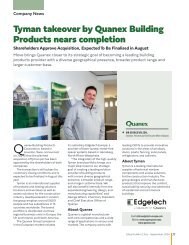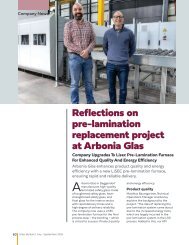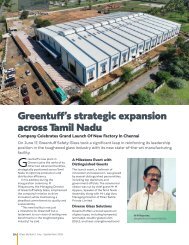Edition 57 (Jan-Mar, 2020)
You also want an ePaper? Increase the reach of your titles
YUMPU automatically turns print PDFs into web optimized ePapers that Google loves.
Vitro Architectural Glass• 2
181 Fremont Tower, with Vitro Glass,
named San Francisco’s top building of
decade
San Francisco Chronicle Calls Engineering Marvel ‘The People’s Choice’
181 Fremont, a 57-story office and condominium tower sheathed in Solarban® 70 glass by
Vitro Architectural Glass, was named San Francisco’s top building of the decade by the San
Francisco Chronicle.
Calling it “the people’s choice,”
John King, the newspaper’s
urban design critic, said the
building’s signature sawtooth façade
“hints at the old-school swagger that
made skyscrapers fun in the first
place”.
While King praised the building’s
engaging appearance—Manus Heller
Architects created the sawtooth
pattern to serve a more vital purpose—
which was to help make 181 Fremont
the most resilient tall condominium
structure on the West Coast.
Working with Hartung Glass
Industries, Seattle, a member of the
Vitro Certified Network of glass
fabricators, Vitro Glass supplied
more than 6,000 insulating glass
units (IGUs), including hundreds of
differently shaped triangles, gables and
other shapes to Benson Industries,
the building’s curtainwall designer,
engineer and installer.
Jeffrey Heymann, vice president of
Benson Industries, said the complex
design required each IGU to be
modelled in three dimensions so the
connections and milling for each unit
could be studied in-depth. Getting
the right fit for each angle in the
curtainwall took several months, but
the effort helps ensure the structure
will withstand seismic events up to 8.0
magnitude. The design also disrupts
airflow, which reduces the impact of
wind forces on the building’s upper
floors.
Hartung Glass heat-treated and
laminated 1,500 IGUs, including up to
800 in large sizes ranging from 58-by-
125 inches to 58-by-144 inches. Chuck
McMullen, senior account manager
for Vitro Glass, said that the large
triangle units were the most difficult
to manufacture. “When they were
heat-treated, the sharp edges of the
triangles tended to curl at the points.
There were also many different-sized
triangles, so as the building rose in
height, the panel sizes would change,”’
he added.
Benson also designed the sealant
joints between the glass and
aluminium framing to be a half-inch
larger than usual, which ensures
that the glass will never touch the
curtainwall framing even at the most
extreme level of seismic racking.
As the first building in San Francisco
to achieve LEED®-certification at the
Platinum level, 181 Fremont also is a
model of energy efficiency, due in large
part to the use of Solarban® 70 glass.
With visible light transmittance (VLT)
of 64% in a standard one-inch IGU,
Solarban® 70 glass delivers a solar
heat gain coefficient of 0.27, which
makes it ideal for balancing demand
for both daylighting, views and energy
efficiency.
About Vitro Architectural
Glass
Vitro Architectural Glass, part of
Vitro, S.A.B. de C.V. (BMV:VITROA),
the largest company of its kind in
the Americas, manufactures a range
of industry-leading, energy-efficient
products such as Solarban®, Sungate®
and Starphire Ultra-Clear® glasses at
US plants in Carlisle, Pennsylvania;
Fresno, California; Salem, Oregon; and
Wichita Falls, Texas. The company also
operates one of the world’s largest glass
research and development facilities in
Pittsburgh and four residential glass
fabrication plants in Canada.
Website: www.vitroglasshub.com
Glass Bulletin | January - March, 2020 87


















